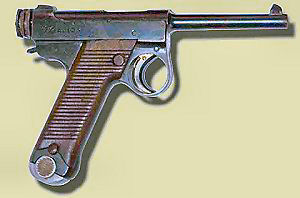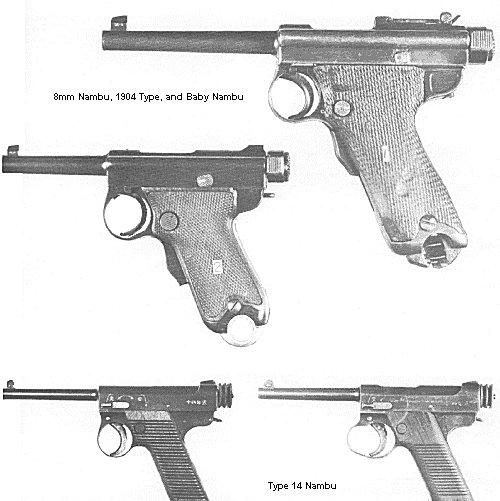| - | 1904 Nambu | Baby Nambu | Taisho 14 Nambu | | Caliber | 8mm | 7mm | 8mm | | Operation | Recoil, Semi-Auto | Recoil, Semi-Auto | Recoil, Semi-Auto | | Length, Overall | 9 in | 6.5 in | 9 in | | Barrel Length | 4.7 in | 3.25 in | 4.7 in | | Feed Device | 8 round, in-line, detachable box magazine | 7 round, in-line, detachable box magazine | 8 round, in-line, detachable box magazine | | Sights, Front | Barley corn | Barley corn | Barley corn | | Sights, Rear | Tangent, w/notch | "v" notch | Undercut notch | | Weight | 1.93 lb | 1.43 lb | 2 lb | | Muzzle Velocity | 1065 fps | 1050 fps | 1065 fps | | Ammo | bullet 103gr, charge 3.5gr | bullet 55gr | bullet 103gr, charge 3.5gr | | Muzzle Energy | 259 ft-lb | 135 ft-lb | 259 ft-lb | | The 1904 Nambu was probably mis-named by Westerners because of a wrong interpretation of the Japanese system of chronology, the pistol's "04" designation probably referring to the fourth year of the Taisho reign -- 1915. The pistol exists in several types. The first version has a tiny cramped trigger guard and a magazine bottom of wood. All the first type pistols have a butt grooved for a telescoping wood/metal shoulder stock. The second version has a magazine, the bottom of which is aluminum, and a larger trigger guard. Designed by Kijiro Nambu, this pistol was never accepted as an issue weapon, although many were purchased by Japanese officers. The smaller Baby Nambu was issued to staff officers. The Taisho 14 was an improved 1904 Nambu. That is, it was improved by simplifying the design to facilitate production, but did nothing to the striker spring which remained a potential source of misfires. It had double recoil springs, plus a magazine retaining spring on later models, which made removing the magazine difficult under combat conditions. The right-hand photo shows the enlarged trigger guard later added to permit gloved fingers. Its safety catch needed both hands to operate. Many officers, Japanese and doubtless some Chinese, were killed in action as a result of this poor design. | 
| Whatever one may say of its design, "poor" weapons like these in the hands of determined soldiers defeated "good" weapons in the hands of the armies of the west, both at the start of WWII and when the CCF first entered the Korean War. The Korean War was essentially an infantry war, and infantry wars are fought by small arms and men, not small arms alone.
Causes of the Korean Tragedy ... Failure of Leadership, Intelligence and Preparation
The Foundations of Freedom are the Courage of Ordinary People and Quality of our Arms
| | |


